Catch our designer/founder Stephanie Ostler on CJSF 90.1 Fm this Friday April 20th, 5-6PM on ESSENCEtial Conversations with Lucca & Rebecca!

Catch our designer/founder Stephanie Ostler on CJSF 90.1 Fm this Friday April 20th, 5-6PM on ESSENCEtial Conversations with Lucca & Rebecca!

As soon as the soft pink cherry blossoms flock the streets of Vancouver, I know Spring is just around the corner! With spring comes a touch more warmth and in turn being able to leave the house with a few less layers.
One of our latest items to spring into stores is the Serena cropped sweater. Knitted from a cotton and rayon yarn blend, this sweater has a lightweight and luxurious feel perfect for the change in weather. The cream tone is a great neutral to move away from the heavier grey tones and masses of black clothing that we tend to cling to in the winter. The ever so slight bell sleeve adds a flirty, feminine feel to any look.
I believe a good cropped sweater can be a staple in any wardrobe. If you are unfamiliar with this higher hemline, that can feel a little daring for some, here are just a few of the ways I’ve learned to style cropped sweaters:
A printed skirt is a great way to draw attention to another part of your outfit aside from the bold choice of a cropped sweater. Play up the spring vibes by throwing on your favorite denim jacket!

A cropped sweater over a fitted dress will emphasize curves and draw attention to a cinched waist. Take this look from day to night with some elegant jewelry and your favorite heels.
High waisted pants and a cropped sweater are a style no-brainer. To draw even more attention to the waist, add on a bold belt or opt for a cropped jacket or vest as an additional layer.
Shift dresses are a great way to show off your legs and a cropped sweater tucked overtop adds dimension to an otherwise simple look. A platform heel and some thigh highs will elongate legs even further and make this a total power fit! 
Let us know which look is your favorite or send us a picture of your favorite cropped sweater styles!

I’m sure many of you can vouch from experience, not all stockings are created equal. We’ve all had that one pair of tights that ripped as soon as our foot slid into the thin, meshy fabric. Luckily, nowadays there are many manufacturers of stockings, tights, and thigh highs (hey, like us!) that you can rely on for more than one use. Here’s a look at just how the modern day stockings came to be!
Stockings emerged from the sock, whose earliest appearance dates back to the times of cavemen. These ancient socks would be handmade from animal furs and hides. In the 16th century, socks were often a sign of nobility. Moving on the 18th and 19th century, both nobles and townspeople alike would wear socks and/or stockings. This was not limited to women, and in fact stockings were commonplace in a man’s wardrobe. The deciding factor between sock and stocking was length, stockings being a good deal longer. Stockings made from silk and intricately embroidered by hand would be worn by nobles, as opposed to those plain and woven from cotton worn by townsfolk.
The purpose of stockings for warmth, modesty, and protection stuck around into the early 1900s, especially as dresses became a great deal shorter during the Flapper era. However, at this time stockings were still made primarily out of silk which was costly and did not hold up well with wear and tear.
In 1939, the realm of stockings would be forever changed as manufacturing company Dupont made the first ever pair of nylon stockings. These did not wrinkle and were much stronger than their silk counterpart and less likely to run. Until the late 40s, stockings were made with the seam running up the back of the leg and only came in a small variety of nude shades. Unfortunately, they still had to be held up by a girdle or a garter belt.
Finally, the world would get to experience the full-leg coverage of pantyhose! The idea of combining underwear and stockings into one was conceived by Ethel Gant, initially branded as panti-legs. She made her vision a reality with the help of her husband, who was the owner of Glen Raven fabric manufacturing company. Stockings were still around but saw a decrease in popularity with the ease of use of pantyhose. Those that were still worn no longer had the seam running up the back.
Besides some modern advances in manufacturing techniques that allow for more comfortable and breathable fabrics, stockings have not changed much since the 60s other than that we no longer have to wear them! It is now a choice to show of some funky stockings or flaunt bare legs! Personally, I am head over heels for our bamboo blend thigh highs as they are the perfect balance of comfy and sexy (pictured below in Flint and Platinum).
And that brings us to the end of this mini-series A History of Lingerie! At Devil May Wear, we always advocate for finding the lingerie that will help you look and feel your very best! So whether that’s a metal-boned corset or a pair of our bamboo hot shorts, treat yourself to feeling amazing underneath it all.

Shape-wear has always been an important part of lingerie. What was once used to enforce “the perfect feminine silhouette” has evolved into playful, even provocative styles worn today at leisure. The girdle and the garter belt are two undergarment staples whose appearance and function has changed significantly to meet our modern day lingerie needs.
Moving away from the restrictive shape-wear of the decades prior, such as the metal boned corsets of the early 20th century, the girdle first came about in the 1930s. Initially, it was a full body girdle with a bra, skirt, and garter straps all in one. Near the end of the 30s, it became more common to have a separate bra and girdle. The girdle was a stepping stone towards creating undergarments that were more comfortable for women, especially as this was around the time many women would be entering the workforce.
By this time, there were 3 typical styles of the girdle. A step down from the full body girdle was the full leg girdle, which covered from the waist to above the knee. This was followed by waist girdles, which look much more like a garter belt, and were intended to flatten the stomach as opposed to slim the entire figure. Lastly, as women began wearing pants, panty girdles came about which were essentially a shapely biker short with the garter clips for stockings.
The same styles of girdles from the 40s stuck around into the next two decades evolving only slighting in shape and material. Women were still “required” to wear stockings until the 1960s so the undergarments still served as a functional piece, as the stockings needed the garter clips to be held in place.
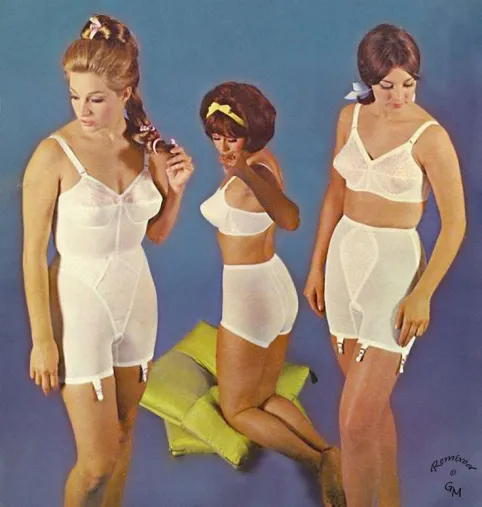
The 1970s moved away from the necessity of girdles and they were transformed into the garter belt. Now that stockings were made that either had a top or could stay up without clips, garters became a fashion statement instead of a functional garment. It was no longer out of place to see intricately adorned garter belts with lace and frills.
Finally, to the modern day garter! From the sexy strappy cage garters to the flirtatious lace garters, today’s realm of garter belts knows no bounds with a plethora of stunning embellishments and materials to choose from. Here are two of our very own garter favorite styles!
If you want to learn a bit more about the history of lingerie check out our recent blog posts and check back in a week for the history of stockings!

Undies, panties, knickers, skivvies, unmentionables, (or whatever else you may call them!) have come a long way since they were first around. Whether you’re a lingerie fanatic or simply appreciate the timeless bikini brief, we must thank the innovation over time that led to the underwear we know and love today.
So let’s take a peak at where it all began!
As previously mentioned in the last segment of “A History of Lingerie!“, the loincloth is the earliest known form of underwear. This undergarment was only a small piece of cloth draped over the hips and through the legs with the sole purpose of its existence being modesty.
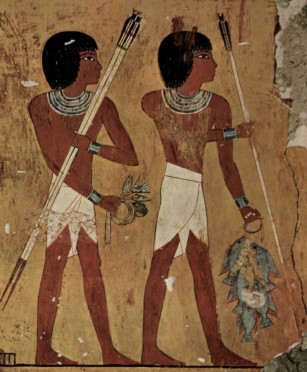
Jump ahead by a few thousand years, underwear hadn’t changed all that much until the 19th century, though much of the shape wear and fitted undergarments had (but that’s all for another blog!). As skirts became shorter and modesty was still a major concern, the pantaloons and bloomers emerged. These oversized, unshapely pants were worn under skirts and dresses to ensure that no part of the leg was left exposed. Over time, this undergarment would evolve into the first trousers made for women as a result of the women’s suffrage movement. Thanks ladies!
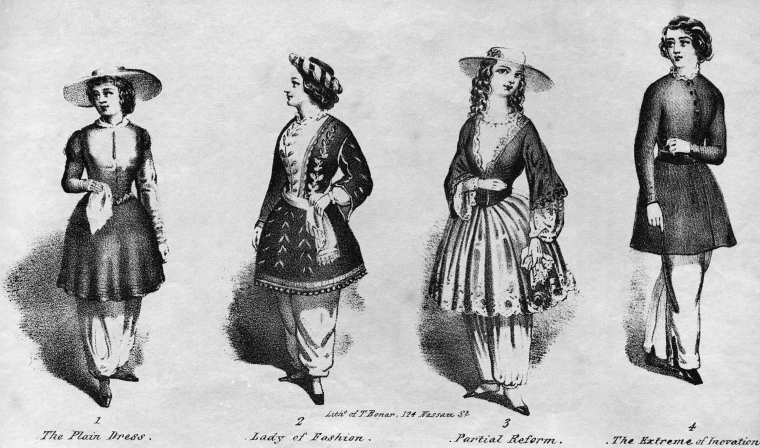
The only thing better than wearing a camisole and knickers? Wearing cami knickers of course! A camisole and undies conveniently sewn into one piece! This style of underwear became popular in the Flapper era, as it fit smoothly under the short, flirty dresses of the time. Women began to embrace their natural figures rather than continue to carry out traditional “feminine ideals” through restrictive, bulky undergarments.
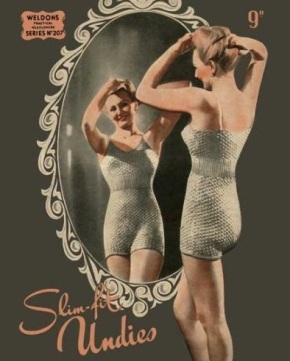
This period marked the end of confining, inhibitive underwear. Comfort became a huge factor in the styles created as well as personal taste. Women could now find the undies that best suited their with a variety of colors, patterns, and embellishments to choose from.
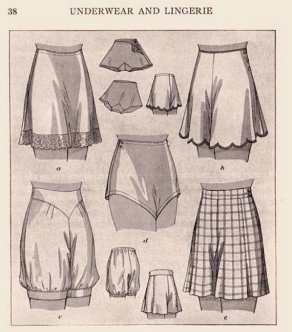
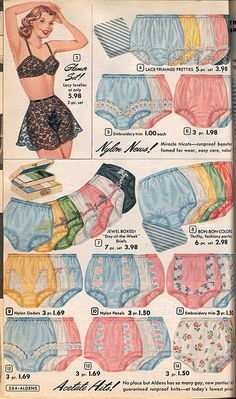

I doubt the bikini brief will ever go out of style with its timeless shape and endless popularity. This style rose to fame quickly with developments in the textile industry. Fabrics such as rayon and spandex came about which made underwear more breathable than it had once been with some additional stretch.
The thong is one of the more controversial lingerie staples to date. Despite their provocative, barely-there appearance, thongs were originally marketed as a seamless undergarment to be worn under tightly fitted clothes. Women everywhere were thrilled to escape the dreaded VPL; visible panty line. If thongs just aren’t your thing, luckily new technology and material has allowed for more comfortable seamless alternatives.
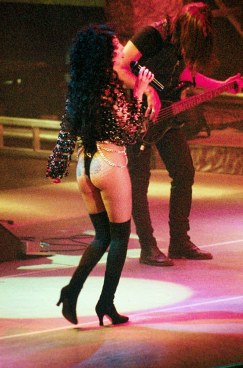
Though I can’t predict the future and see what undergarments will be like in 2085, I’m incredibly thankful I don’t have to wear a pair of pantaloons everyday!
What’s the history behind your favorite pair of undies? 🙂

The wonderful world of lingerie has been around for thousands and thousands of years, but its purpose, style, and construction has evolved drastically over time.
The earlier forms of undergarments such as the loincloths of the 5th Century BC and the chemises’ of the Middle Ages served a purpose of practicality and modesty. Historically, you could determine the upper class from the lower class simply by what their underwear was made of. A silk loincloth was a distinction of high society!
The 16th and 17th Century introduced the corset into the closets of many women, though for some this trend was surely not willingly followed. Often causing a great deal of discomfort, the corset was intended to reduce the appearance of the waist and flatten breasts to create a modest, yet feminine silhouette. This lingerie staple eventually died out, though it has re-emerged in modern culture through burlesque performance and waist training, or cinching, shape-wear.
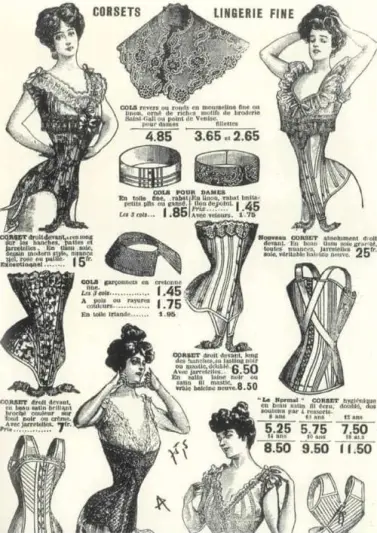
It wasn’t until the early 20th Century where the lingerie we know and love today first appeared, and the term became widely used. Underwear was no longer something to hide or conform the figure to particular beauty standards. It became much more decorative, and women had more of a choice as to what they could wear. Modesty was no longer part of the equation.
The technological advances of the fashion manufacturing industry are responsible for the extravagant embroidery, delicate trims, and luxurious yet comfortable fabrics now used to create lingerie. Though some of these embellishments to lingerie had been used prior to the 20th Century, they were most often done by hand and very time consuming.
With Valentine’s Day just around the corner, it’s the perfect time to learn a little bit more about your underwear and how it’s made! Check back on our blog for the next weeks to hear more about the evolution of underwear, the garter belt, and the classic stocking!

Are you a Virgo? Do you have a fabulous eye for details; a great love for beautiful, yet versatile, garments? Or perhaps, all of the above, and in search of a skirt?

Our new Virgo skirt is fresh from Stephanie’s sewing machine – boy is it divine!
A gorgeous, lightly textured charcoal grey, which makes it a dream to pair with other colours and textures. An attached sash gives this lovely simple skirt nice flare without sacrificing any of its sophistication.
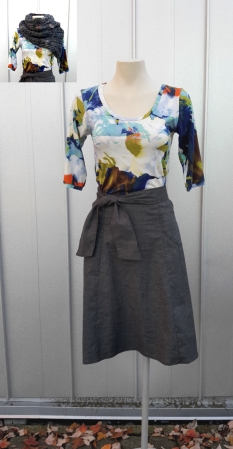
An A-line cut with flair, it is a great mix of playful and feminine, yet classic, making it perfect for dressing up or wearing casually.
Lets talk fabric: this beauty is made of both hemp and recycled polyester. Hemp is a wonder-woman kind of fabric. Not only is hemp environmentally friendly but it is one of the strongest fibers, retaining its shape and wearing in, rather than wearing out. Hemp is also naturally resistant to both mold and ultra violet light and, to top it all off, it’s breathable! Combine this with recycled polyester and you have an environmental dream team with amazing looks and that wears fabulously.
Our Virgo skirt is at both of our beautiful shops in wait for you to ogle it, try it and buy it!

Hemp properties resource;
https://www.hemptraders.com/Hemp-Textile-Properties-s/1881.htm
I find that this time of year has a chaotic feel to it, especially as a student when you are swamped with deadlines it can be hard to relax. I know that many of my close friends are feeling this chaos and stress as well, which is why I think it is the perfect opportunity for a soiree!
There is really no better way to bring people together than with good food, good drinks, and good music. Whether you’re interested in hosting a full scale cocktail party or an arts and crafts night, this 60s and 70s inspired playlist sets the mood for an intimate evening that will give you a break from the mayhem of everyday life.
Tracklist:
Give it a listen at our 8tracks account with the link below and have some fun with good friends!
https://8tracks.com/devilmaywear/soi-ree

On Tuesday, September 26th, 2017, we had our 5th annual Earth and Wear at the gallery of BC Ceramics. Newly inducted ceramic artists, Amity Design Studio and Devil May Wear created a luxurious boudoir theme to our pop up show this season. The silk kimono jackets from Amity along with the new French cut lace colors at Devil May Wear mixed perfectly with the stunning ceramics that are now available at the Gallery of BC Ceramics on Granville Island.
Here is a peek into the beauty that was our show!
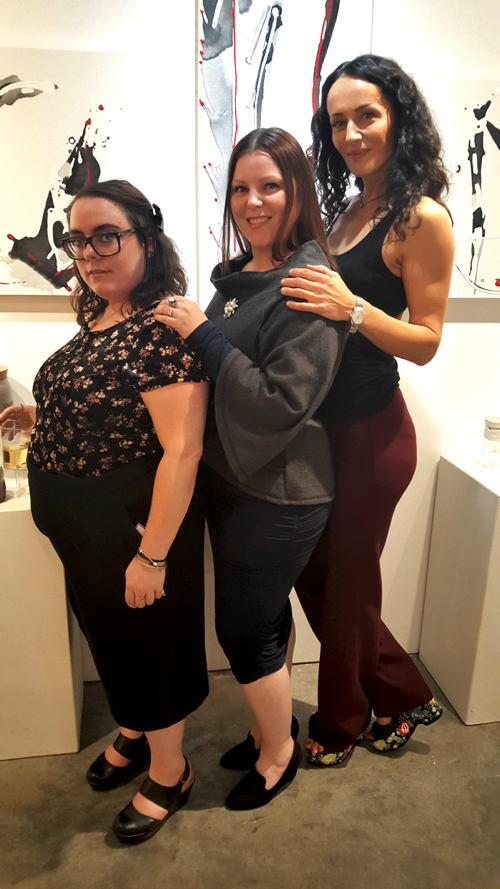

I am so excited to announce Devil May Wear was voted by all you lovely people as Vancouer’s BEST LOCAL DESIGNER CLOTHING STORE!!! WE GOT NUMBER ONE!!!
Thank you thank you so much to everyone who voted, supported, helped us become who we are today and continues to help us grow and blossom.
WOOOO HOOOO!!!